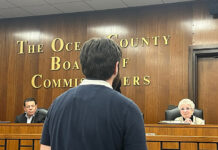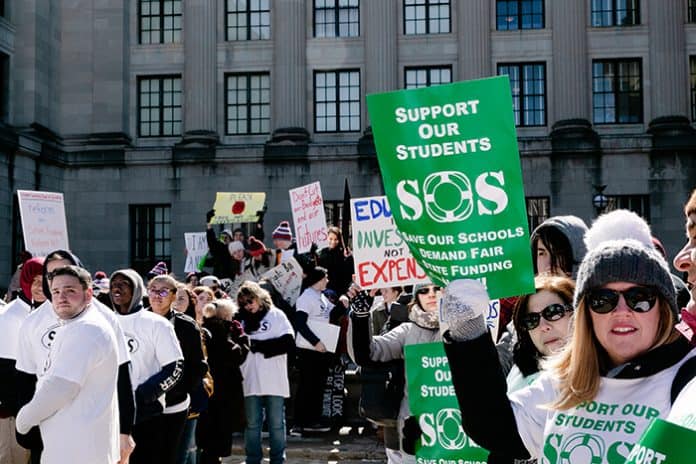
TRENTON – From Calhoun Street, walking east toward the State House on West State Street, a rushing sound of cheering in unison hits your ears when you reach the New Jersey State Museum. You can distinguish phrases a little better by the state library – “Hey hey, ho ho…” and “Two, four, six, eight…” – when you realize it’s not a large, possibly spontaneous outdoor concert but a protest of some sort.
Once you get to the State House annex, you see the T-shirts signaling distress: SOS. Support Our Students. You see the poster board signs: Don’t cut our budgets and our futures. Education is an investment! Not an expense!!!
Just a couple hours before Governor Phil Murphy presented his $38.6 billion 2020 budget, hundreds of students, parents and staff – many from the Toms River Regional School District – gathered outside to protest cuts that threaten the stability of their schools.
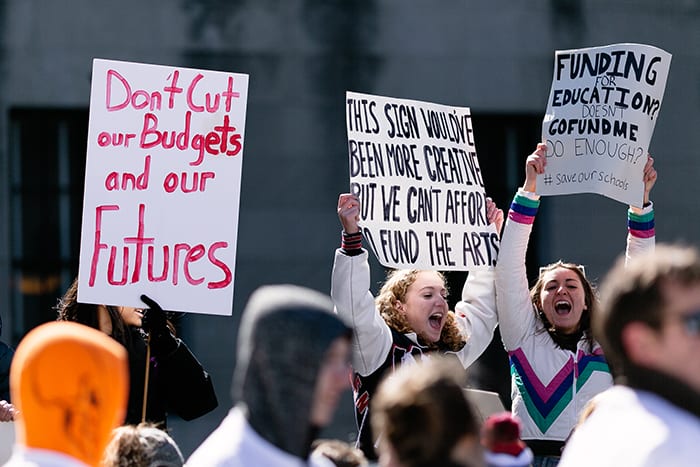
Murphy’s office issued this brief statement about what this budget does for school funding: “The Governor’s budget maintains the commitment to our kids and our public schools – starting with an additional $206 million to continue our ramp-up to full K-to-12 formula funding, and $68 million to not only maintain, but to further expand, pre-K. The budget also proposes $2 million to continue the ‘Computer Science for All’ initiative.”
That’s not the reality for more than 70 districts across the state, who because of what school officials call a “flawed funding formula” will see “catastrophic” cuts to their districts over the next several years.
Michael Harris, school superintendent in Southampton Township (Burlington County) and coalition chairman, said the coalition was founded at the New Jersey school boards convention in October with 34 districts and has grown to 73 districts and 160,000 students. But he said he feels the coalition represents every child in the state, as its advocating for “fair funding for all districts.”

Ocean County communities and their economies are still recovering from Superstorm Sandy, which devastated the region back in 2012. The Toms River Regional School District, which officials there say is already $30 million underfunded, will under this formula lose another $80 million over the next 6 years.
What does that look like? Four hundred staff cuts. Cuts to nonmandated programs like athletics and music. Classroom sizes of 30 to 40 students.
“Toms River will be fully gutted, decimated. There’s no way we’re going to be able to operate a school district with those kinds of losses,” Toms River Superintendent David Healy said. “It’s just not possible.”
The funding formula isn’t written for mere mortals to decipher, according to the most impacted districts. Peeling away the layers of what can only be labeled “the new math,” some municipalities lined with mansions are Mercedes-Benzes are somehow deemed “poor” while lower- to middle-class municipalities are considered “wealthy” and overfunded.
“The formula doesn’t accurately portray districts in terms of their wealth or lack of wealth,” Healy said.

Brick Township schools stand to lose $21 million over 7 years if the formula doesn’t change.
“I don’t think people are realizing the severity of the cuts,” Brick Superintendent Gerard Dalton said. “Our concern is in the long term. We need to stop the cuts where they are right now, and we need to step back, and we need to come up with a plan that’s going to work in a fair and equitable way for the long-term for our state that is also more predictable.”
If things stay as they are, Dalton said Brick stands to lose 290 staff (and, consequently, larger class sizes), lose after-school activities, and force some of the district’s buildings to fall into disrepair.
“Not having fair funding is going to put a strain on our taxpayers in Brick,” Mayor John Ducey said. He was holding a green and white ‘Support Our Students’ sign. “If you’re going to cut back state aid, you’re going to have to raise the money, because education is so important for the kids. They still need their education, so our taxes go up. When our taxes go up, our property values go down. And even with our taxes going up because of the amount of cuts they’re talking about, our education system is going to go down, and still hurt our property values. That’s not something you want to see as a mayor, or parent, or any individual who lives in town.”
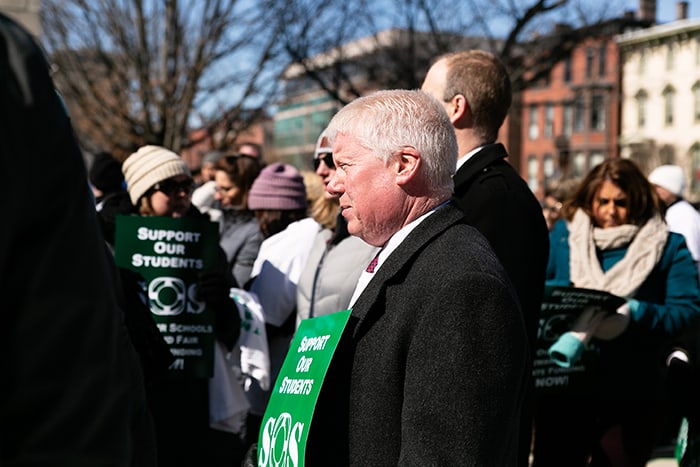
Harris said the formula needs to be looked at, and parts of it tweaked. He’s not anyone to start from scratch; there are aspects of the formula that are good, he said.
“Schools account for much of the taxes. But, we’ve got to look at all the wasteful spending and inefficiencies that takes place throughout the state, and not always target educators and teachers and schools. That’s just not fair,” Healy said. “Just as the formula needs to be looked into, and modernized, every corner of government spending needs to be looked at, not just education.”
Murphy, busy preparing to deliver his budget presentation, sent out his Deputy Chief of Staff of Outreach Deborah Cornavaca to apologize to Healy for not being able to personally meet with any of the leadership Tuesday. Cornavaca did tentatively invite Healy and a small group of other superintendents to meet with the governor’s chief of staff, George Helmy, if time allowed later in the afternoon.
That meeting did take place, Healy confirmed in a phone call after the rally. He and a group of school officials with have another meeting with Murphy’s staff March 8 in Trenton.
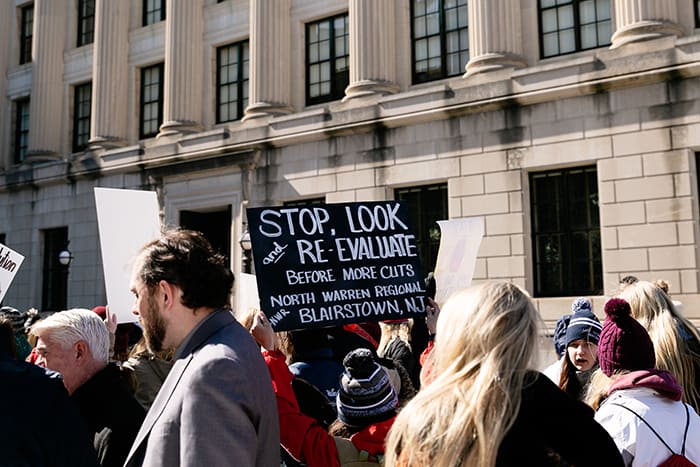
“We engaged in a productive dialogue. Our sense was, that the governor and his staff are sincerely working to address the concerns we’ve been presenting. We probably remain more hopeful now than we’ve ever been in terms of our efforts in the last five years with various legislators,” Healy said. “We’re extremely hopeful and optimistic.”
The focus needs to be on the kids, Healy added.
“Our purpose in coming out here today is to be a visible presence to the governor and the legislators, to let them understand there is a high level of concern throughout the state from school districts that are losing state aid,” Harris said at the rally. “This is a start today. We consider this a marathon. It’s not a sprint. Going forward, we’re not going away.”



